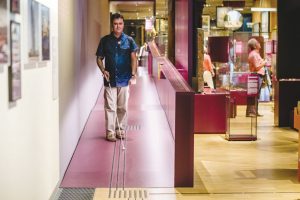Impact-focused architecture and design studio, HCMA, has published research that shows the Rick Hansen Foundation Accessibility CertificationTM (RHFAC) can be achieved for new buildings at no additional cost through thoughtful planning and design. The cost comparison feasibility study also finds that new buildings could achieve ‘Accessibility Certified Gold’ status – the highest tier of accessibility under the RHFAC program—if construction costs were increased by as little as one per cent.
RHFAC rates the level of meaningful access of the built environment, keeping in mind user experience of people with varying disabilities affecting their mobility, vision and hearing. To date, over 1,200 buildings across Canada have been rated through the program. Public and private sites, as well as multi-unit residential buildings can achieve ‘RHF Accessibility Certified’ or ‘RHF Accessibility Certified Gold’ levels by scoring at least 60 per cent or 80 per cent respectively on the RHFAC Rating Survey.
The report, called the Cost Comparison Feasibility Study, compares the RHFAC program with Canada’s 2015 National Building Code (NBC) and the 2018 Ontario Building Code (OBC). The findings demonstrate that NBC and OBC on their own do not meet RHF Accessibility Certification, but that accessibility can be achieved with no cost impact to building owners, developers and designers.
Key findings of the report include:
• On average, there is only a 1% construction cost increase to build to RHF Accessibility Certified Gold, when meeting NBC or OBC.
• New projects can achieve RHF Accessibility Certification (or a score of 70-74% on the RHFAC Rating Survey) at no additional cost through thoughtful planning and design, when meeting NBC or OBC.
• Projects built to meet the requirements of National or Ontario building codes alone would not achieve RHF Accessibility Certification.
• Office buildings incur the smallest cost increase to achieve RHF Accessibility Certified Gold at a cost increase of approximately 0.4%.
• Meaningful accessibility can be achieved with minimal cost impact through a commitment to thoughtful planning and design, i.e. material selection.
• Brad McCannell, Vice President of Access and Inclusion at the Rick Hansen Foundation, suggests that, “as it stands, the greatest barrier to meaningful accessibility in Canada’s built environment is an attitudinal one, and there is an unspoken assumption that accessible buildings are expensive and difficult to build. This report unequivocally shows that this is not the case.”
“Barriers are preventing people with disabilities from becoming an active part of Canadian society and more needs to be done to improve accessibility in the built environment. A collaborative approach between the government, and public and private sectors, could help to realize a more accessible built environment at no additional cost,” continued McCannell.
Darryl Condon, Managing Principal at HCMA said, “Incorporating meaningful accessibility into buildings is currently perceived as an added bonus in our industry, when in fact this should form an integral aspect of all building designs. We hope the findings from this research will help to educate people on the feasibility of embedding accessibility into all new buildings through thoughtful and considered planning and design.”
To view the full report, please visit: www.RickHansen.com/reports
















